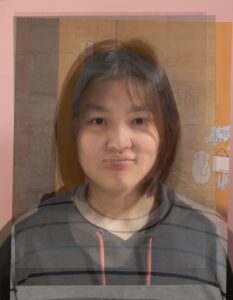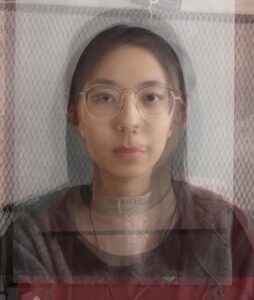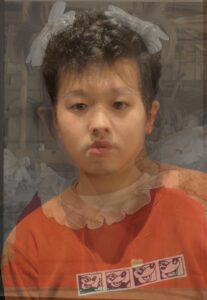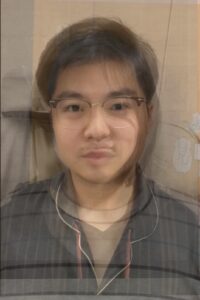Thesis User Test 1
Specific test methods:
0: Take a 45-second video portrait of them without sound. (as material for collection). Process the video on the iPad and take a screenshot. The images are then combined in the app Procreate and output a video of the “creation process”.
1: Asking the people to imagine a situation. They see this exhibition or this installation at the train station or in mall or in the community center or in the art gallery.
2. They walked to the front desk and were told by the staff that this was an interactive art installation about gazing experienced by one person, in which participants needed to be recorded, but the material would not be used for other purposes.
3. After entering the exhibition hall, there is a black space with a TV screen. (I hold the iPad in front of people to simulate a TV. Easy background music will be played from now until the end of the experience.
4: (screen gradually lights up) The screen show the text: “Have you ever gazing at someone seriously?” (fading out)
5 :(screen gradually lights up) Play a 45-second clip of stranger people on the screen (pre-prepared) (fading out).
6: (screen gradually lights up) text appears on the screen: “Have you ever gazing at yourself seriously? (fading out)”
7: (screen gradually lights up) The video recording of the participant just now will be played on the screen for 30 seconds. (playing my prerecorded video) (fading out)
8 (screen gradually lights up) The screen displays a sentence: “Now, will you wanna be a part of us? Come, let us be together, united, to higher altitudes.” (fading out)
9 (screen gradually lights up) Play the video: “a composite portrait of faces, the process.” Viewers will see the faces of strangers stacked on top of each other, ending with last second image of the stranger they were gazing at and a final image of themselves. The final frame is frozen on a translucent, fuzzy layered portrait.
10 Asking people to imagine that a QR code would be generated on the screen: Participants could download the photo on their phone and view a brief description of the visit.
(the End)
Yiqi: The 1 minute gazing of stranger is too long and a little bit uncomfortable. If the environment is quiet, 30 seconds is more appropriate. The process of looking at strangers and looking at oneself is very interesting. In the composite photo, the shadow of the user is too obvious. You want to reduce your sense of personal center. A brief explanation of 100 words is required after the conclusion.
Li: It’s a bit too long, maybe 30 to 45 seconds. I want to have one-on-one eye contact, don’t want random people, but more interaction.
Yiru: The experience of looking at strangers and looking at oneself is good, but the feeling is not strongly correlated with the end result. Hoping to give some indication or guidance. In terms of understanding, I hope to be more thematic. It could be more technical, such as eye monitoring, which blurs the screen if it detects that the user is not looking at the screen. Put a little more thought into how to design interactions.
Siyan: I think it’s all right, I have mood swings, I feel a little strange when I look at myself, because it’s not synchronous, I haven’t looked at myself seriously for so long. Although in the end it doesn’t feel particularly obvious. But it can be reinforced in a booklet. Don’t put too much guidance in the exhibition.
Rudi: The experience and the concept are all fine, but when it comes to refining this stuff down to simple conditions that can be produced, think about what’s really important. Make an operable version first.
Despina: You have to speed things up and think about how to make a simple example to show the final product. Make a schedule. Get more people to test it.
Jiajie: When you look at a stranger, you want the facial expression to change, even if it’s a video portrait, and you want more movement across the face. When I look at myself, I feel very close to looking at myself in a mirror. The composite photo was just a bit of fun.
Wenqi: The process and experience are OK. I’m afraid that the actual ritual will not be enough. It is suggested to replace the black room with a pure white one, and the display could use the stone monument from 2001: A Space Odyssey. All in all, a little more ritual.
Xichen: It’s more interesting if you’re looking at strangers that are less common and you’re looking at people from other countries, other ethnic groups. I don’t think I fully understand the last part, so I hope artist can explain it a little more.
Hongyi: At present, all the materials collected are shot by mobile phones. Some of them were shot by my friends and sent to me. So the composition and the background are different and there are a lot of uncertainties. Different lens and, will produce different distortion, resulting in the face of the five features are not easy to align. The single character sample is also a great regret. The design and textual instructions of the booklet are worth careful consideration. I want to make the installation itself artistic and abstract. If the participants do not understand, they can find an explanation in the text of the booklet.




Related Posts
Leave a Reply Cancel reply
You must be logged in to post a comment.
Kat Sullivan
Adam Colestock
Helen (Chenuan) Wu
Christina Lan
Dorian Janezic
George Faya
Julia Myers
Kelsie Smith
Michael Morran
Po-Wen Shih
Liu Siyan
Fisher Yu
—
Craig Protzel
Christopher Wray
Haoqi Xia
Hayden Carey
Katherine Nicoleta Helén
Maria Maciak
Parisa Shemshaki
Sakar Pudasaini
Skyler Pierce
Steven Doughty
Yiqi Wang
—
Andrew Lazarow
Benoit Belsot
Enrique García Alcalá
Hongyi Zhang
Jay Mollica
Li Shu
Teddy (Jian) Guo
Monika Lin
Wenye Xie
Yiru Lu
